If you want a hearty, shelf-stable meal, start with beef chuck bites, diced tomatoes, carrots, potatoes, corn, green beans, onions, beef broth, and a touch of tomato paste. Brown the beef, soften onions, then simmer with chopped vegetables until tender. Season lightly, add a splash of acid, and keep headspace as you can. This soup yields a rich, protein-packed dinner that stores well. Want more tips to perfect your canning process and flavors? You’re about to learn more.
Ingredients and Quantity
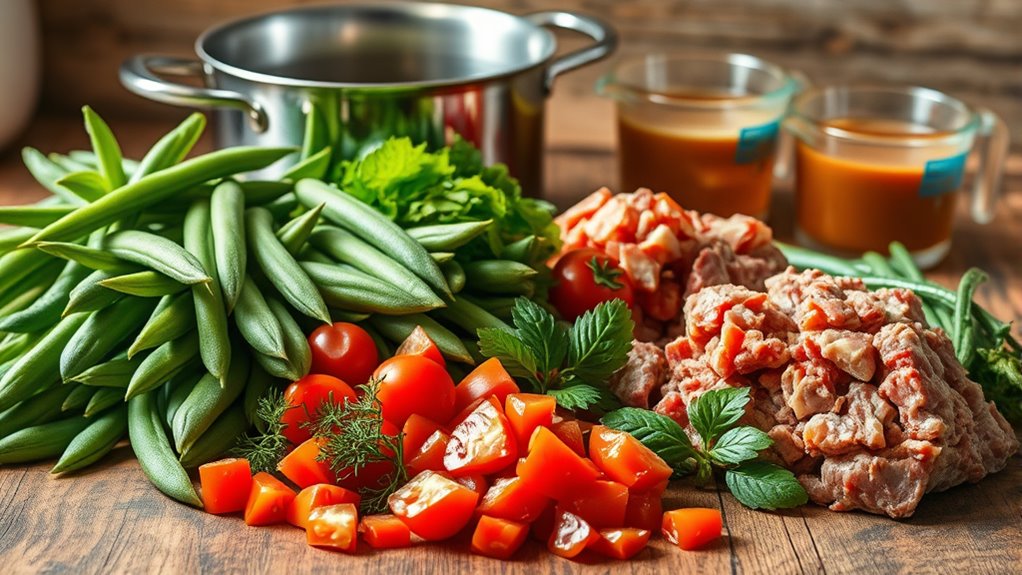
A hearty batch starts with the essentials: beef chuck, diced tomatoes, carrots, potatoes, canned corn, green beans, and onions, all joined by beef broth and a touch of tomato paste.
You’ll consider vegetable selection and beef cuts carefully, choosing sturdy veggies and tender chunks that hold up under canning. For vegetables, think root and sturdy greens that flavor well without turning mushy. For beef cuts, opt for chuck brave enough to survive long simmering and pressure canning.
| Item | Notes |
|---|---|
| Beef cuts | Chuck, hand-picked, cut into uniform bites |
| Vegetables | Carrots, potatoes, corn, beans, onions |
| Liquids | Beef broth, water substitute if needed |
| Flavor enhancers | Tomato paste, salt, pepper |
| Storage prep | Clean jars, sterilized, headspace |
Preparations
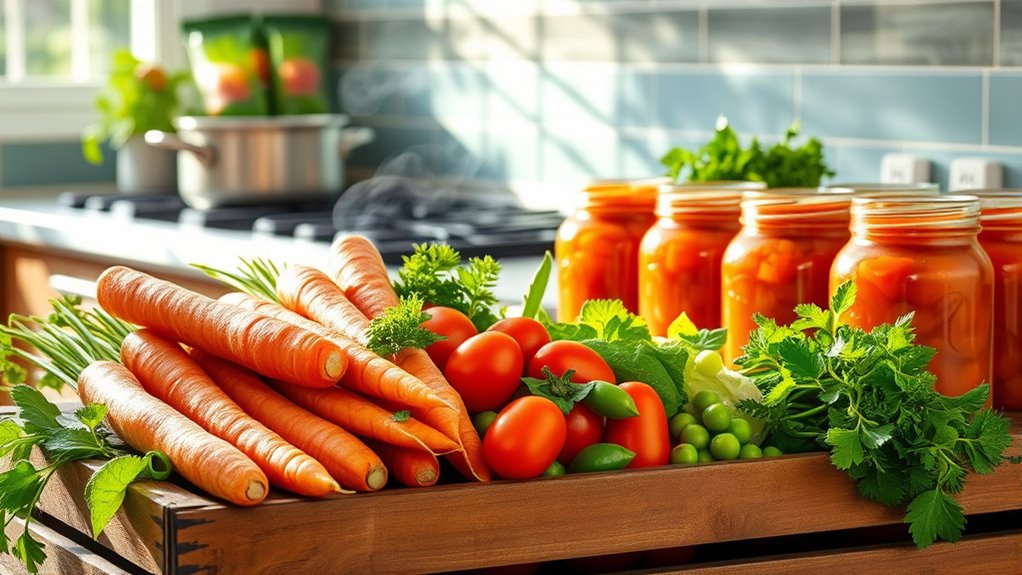
Preparing the ingredients is your next step, so chop the chuck into uniform bites, dice onions, and slice carrots and potatoes into sturdy, bite-sized pieces that will hold up under canning. For soup preparation, you’ll want chunks that balance tenderness with bite, ensuring even heat distribution during processing. Rinse and trim greens, and measure tomatoes, beans, and corn to keep ratios consistent. Keep a clear eye for ingredient selection: choose lean meat, fresh vegetables, and robust herbs that intensify flavor after pressure canning. Season lightly upfront; you’ll build depth during simmering, not heavy-handedly. Organize mise en place in labeled bowls, so your workflow stays smooth. Maintain cleanliness, minimize waste, and trust your palate to guide the final balance of savory, bright, and comforting notes.
Kitchen tools or Kitchenware Required
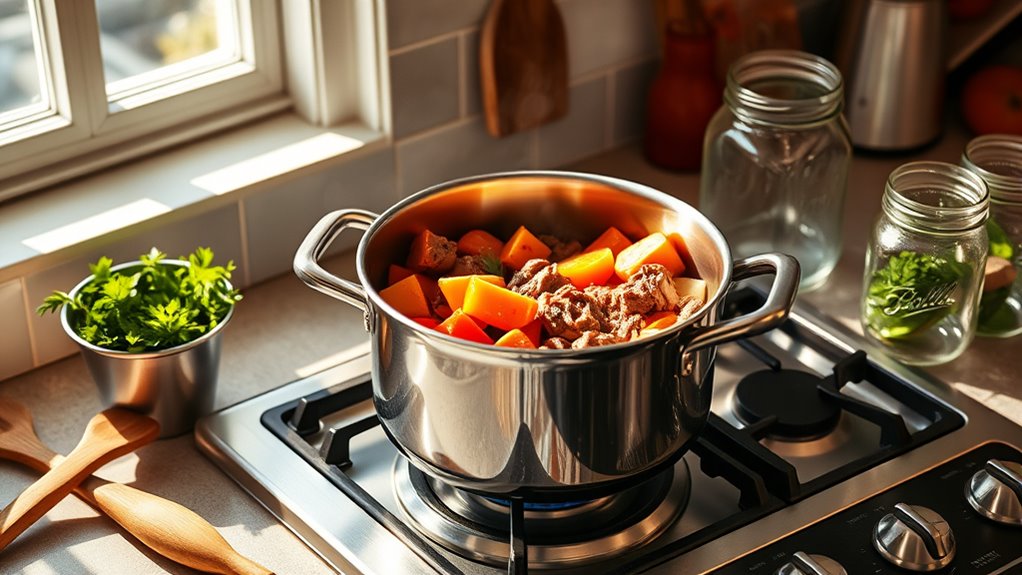
To gear up for canning this hearty soup, you’ll want a few dependable kitchen tools: a heavy-bottom stock pot or Dutch oven, a wide-mouth canner or pressure canner, and a sturdy chef’s knife for clean, uniform chunks. As you prep, think about canning equipment that fits your space and rhythm, not excess clutter. These kitchen essentials keep you efficient, safe, and excited to preserve flavor. The table below highlights key picks and why they matter:
| Tool | Purpose | Benefit |
|---|---|---|
| Wide-mouth jar lifter | Lifts hot jars | Safe handling |
| Calibrated thermometer | Verify temps | precise processing |
| Ladle and funnel | Fill jars cleanly | minimizes waste |
How to Cook
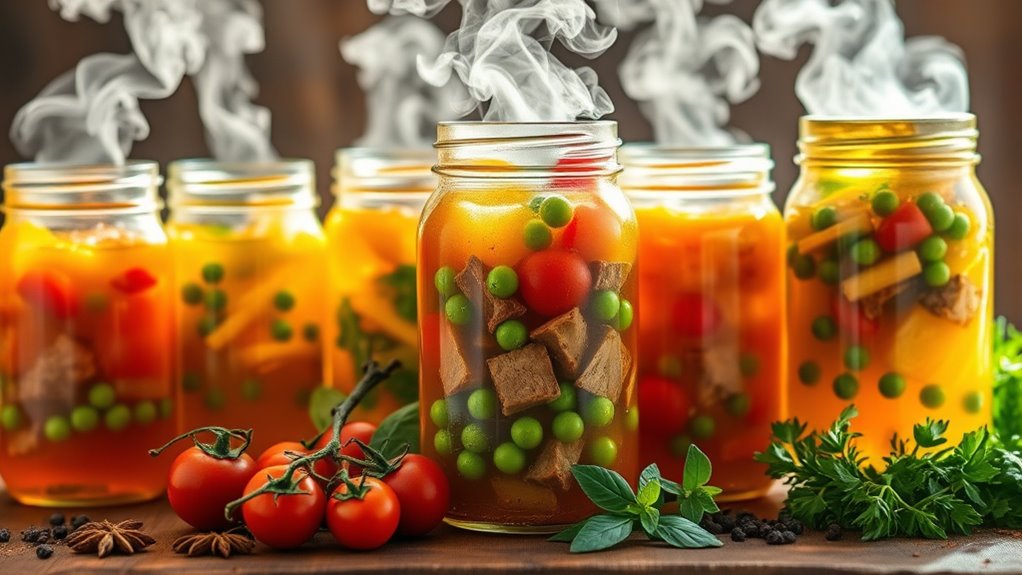
- Brown beef in a pot to develop a hearty base.
- Sauté onions and garlic until their aromas bloom, creating a rich foundation.
- Add chopped vegetables and pour in broth.
- Simmer the mixture until vegetables are tender, stirring occasionally to let flavors mingle.
- Introduce herbs and a splash of acid to brighten the flavor profile without overpowering.
- Taste frequently, adjust salt and pepper as needed.
- Maintain a steady simmer to concentrate flavors while preserving texture and color.
- Follow this lean and purposeful method to yield a robust, soul-satisfying soup ideal for canning, sharing, and savoring.
How to Serve
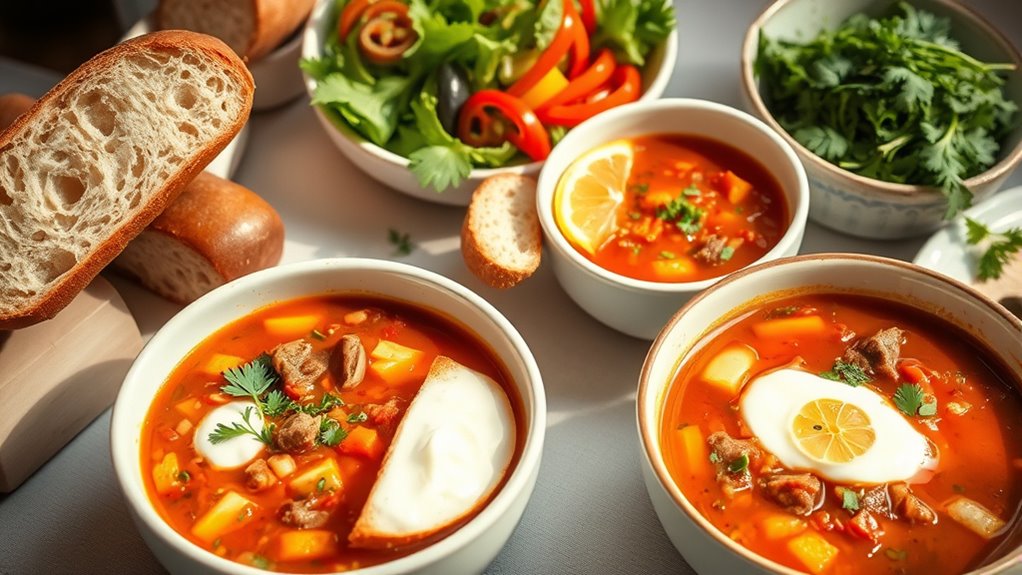
As you finish the canning-ready soup, plate it in bowls with a warm crusty loaf on the side, or ladle into mugs for a cozy, comforting meal. When you serve, keep portions modest to honor the soup’s bright vegetables and beefy depth. Add a bright finish with fresh herbs, a squeeze of lemon, or a dollop of sour cream for smooth tang. Consider serving suggestions that celebrate simplicity: a green salad, crusty bread, and a side of pickled vegetables for contrast. For soup garnishes, sprinkle chopped parsley, chives, or dill, plus a few peppery greens. Present in clear bowls to showcase color, steam drifting upward, inviting another thoughtful sip. Enjoy, sharing warmth and freedom in every bowl.
Tips
A few smart tweaks make this canning vegetable beef soup shine: prep ingredients in advance, trim excess fat, and chop toward a uniform bite so every jar cooks evenly. When you apply canning techniques, you lock in flavor and texture, not just safety, so you feel proud of each jar you grab. For flavor enhancement, layer components thoughtfully—tomato, beef, and vegetables support each other without crowding. You’ll notice bright, consistent results with careful sealing and heating.
- Prep a consistent mise en place to guarantee even heat transfer.
- Balance acidity and salt for a clean, bold finish.
- Label jars with date and batch notes to track flavor evolution.
Food Value and Benefit
Canning vegetable beef soup preserves a nutrient-rich, comforting dish that offers significant food value and health benefits. This hearty soup combines lean beef, tomatoes, and a variety of vegetables, creating a well-balanced meal that supports overall wellness.
Food Value:
- Provides a good source of high-quality protein from lean beef, essential for muscle repair and energy.
- Contains dietary fiber from vegetables, aiding digestion and promoting satiety.
- Supplies important vitamins such as Vitamin A, Vitamin C, and B-complex vitamins.
- Delivers essential minerals including iron, potassium, and zinc.
- Rich in antioxidants from tomatoes and vegetables that help combat oxidative stress.
Benefits of Eating This Recipe:
- Supports immune system health through vitamins A and C.
- Enhances energy levels and muscle function with iron and protein.
- Promotes digestive health and sustained fullness due to fiber content.
- Helps maintain healthy blood pressure and electrolyte balance with potassium.
- Encourages mindful eating with portion-controlled, flavorful servings.
- Convenient and shelf-stable, making it ideal for quick meals and emergencies.
- Pressure canning intensifies flavors, providing a satisfying meal that requires minimal preparation.
Enjoying canned vegetable beef soup is a practical way to nourish your body with essential nutrients while supporting an active and balanced lifestyle.
Frequently Asked Questions
How Long Can Canned Vegetable Beef Soup Be Stored Safely?
Shelf life for properly canned vegetable beef soup is about one year when stored in a cool, dark place. You can trust the canning safety, but check for bulges or leaks before use.
Can I Substitute Frozen Vegetables for Canned in This Recipe?
Yes, you can substitute frozen vegetables. You’ll notice texture differences, but frozen vegetable benefits include convenient, speedy prep. Expect slightly softer chunks; adjust simmer time, seasonings, and liquid to maintain hearty flavor and appealing consistency.
Is Pressure Canning Required or Is Water Bath Enough?
Pressure canning is required for low-acid soups like vegetable beef; water bath isn’t safe. You’ll guarantee shelf-stable safety with proper jars, vents, and processing times—embrace freedom in preserving flavor through careful pressure canning.
What Are Common Flavor Variations for This Soup?
You’ll love swapping herb additions like thyme or rosemary and spice variations such as paprika or cayenne to tailor flavor; you’ll savor a vibrant, freedom-loving twist that keeps you savoring every hearty, comforting bite.
Do I Need to Add Salt When Canning, and How Much?
Yes, you should add salt during canning, but only to taste for the recipe you’re locking in; typically 1/2 to 1 teaspoon per quart, balancing Salt importance with alternatives like herbs, lemon juice, or low-sodium boosts.
